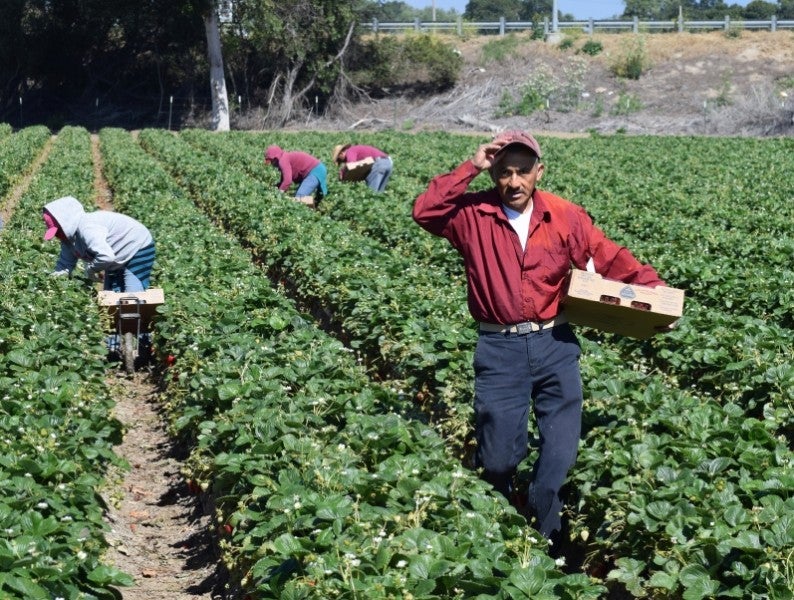
The rise of the gig economy, advances in technology, and further expansion of global markets are among the major forces changing work in America and even giving rise to questions about work disappearing. Given that labor income is how the vast majority of American households pay for life’s essentials and that work, for many of us, takes up most of our waking hours, fundamental changes in the organization of work provoke a fair bit of anxiety. And this is particularly true when for most workers these changes don’t look good.
Many of the changes that have captured the headlines, like the labor practices of tech companies from Uber to Amazon, are part of a longer-term trend that for decades now has meant flat or declining earnings, even as economic growth has been substantial. So workers may be worried this Labor Day. As political candidates compete to address voters’ worries about work, here are a few issues to watch.
Education
Education and skill development are critical pieces of creating opportunity for more workers to climb the economic ladder. Candidates of both parties propose policies to reduce the costs of college, and both parties have state examples to build on. For example in Oregon, the Oregon Promise, which makes two years of college free, was passed by Democrats and builds on the pioneering Tennessee Promise, which was crafted by Republicans. These policies are often couched in arguments about improving the quality of the workforce for business and are helpful — encouraging better connections between education and the labor market in ways that help job-seeking students of all ages achieve their goals. This is important work worthy of investment.
A key component of making college work for job-seeking students is to address the cost issue. Given the limited rise in household earnings juxtaposed against the rapid rise in the price of higher education, college affordability is a critical policy aim; we should not be saddling our youth with crushing debt as they start their careers. Nor should we be excluding young people (and not-so-young people) who have limited means from opportunities to improve their skills and access better jobs. But even students have to eat — true inclusion for economically struggling students will require a more thoughtful approach to assisting with living expenses in addition to help paying tuition. And yet, with even college jobs showing declining earnings, and with so many college-educated young people in non-college jobs, it is clear young people — all people — will need more than a college education to help them earn a living. Education alone can’t address the challenges working people face.
Labor Standards
This category includes things like wage and hour laws, health and safety regulations, child labor restrictions, workers’ compensation insurance, and so on. Most of these laws, even the ones restricting child labor, have been criticized as “anti-business” regulations that stifle job creation and economic growth, and have been slowly eroded over the past several decades both in their legislative form and in their enforcement.
It seems that as a country we decided labor standards were not important or necessary. As a result, the United States stands out among developed countries in its lack of worker protections. For example, every other country but Papua New Guinea and Surinam — and the United States — have laws requiring paid maternity leave. If as a country we believe in the value of work, then we ought to have laws that reflect those values and support basic standards for work.
Neglect of worker standards — at least at the federal level — has until recently been largely a bipartisan affair. But some politicians — primarily Democrats— are now giving worker protections more attention. Recently, the Obama Administration proposed an update to the overtime eligibility salary threshold, which had seen almost no adjustment for the past four decades, and is currently less than the poverty threshold for a family of four. The result of this lack of adjustment is that workers with these very low salaries can be required to work long hours without additional compensation — a real challenge for someone trying to make ends meet on a low salary and some estimate a major contributor to the erosion of the middle class.
The balance of experience over the past four decades, especially when considered alongside the post-World War II period, when we had stronger labor protections, would indicate that worker protections will be an important part of rebuilding the middle class. The first step is to acknowledge that we have a problem with inadequate protections and labor standards in this country. Although candidates may be hearing about it on the campaign trail from struggling working Americans, are they really listening?
Immigration Policy
Our approach to immigration presents a corollary in some ways to worker protections — a Part 2 to the argument that worker protections are needed. Legal immigration has been structured to provide employers with the workforce they need at the price point they are willing to pay, leaving immigrant workers vulnerable to all kinds of abuses, as BuzzFeed documented well in its coverage of the H-2 visa program. Relatedly, the J-visa for foreign students and even the H1B visa, which is supposed to be bringing in skills that are in short supply, can be used to merely replace well-paid workers with less well-paid workers. What all these examples have in common is ways in which the legal immigration system is designed to keep wages low. We are, as the saying goes, largely a nation of immigrants, and immigrants continue to make important contributions to our country. We should ensure that when new immigrants come to America to work, they are not forced into a shadow economy that drags down labor standards for everyone, but rather the value of their contributions is recognized and rewarded.
Rethinking Social Policy
As we think about building a workforce for the future, the economic instability that working families face in the present is a substantial barrier. Expenses for childcare, health care, and housing crowd out savings that could be used to invest in skills or plan for retirement. Do we need underemployment insurance alongside unemployment insurance? Do we need semi-retirement plans as we encourage longer work lives, but also recognize that aging workers may need to work less? How do we structure policies that support strong families as both family structure and the structure of work change? New approaches are needed to build a measure of stability for working people that can then be a platform for enhanced productivity and mobility.
Are candidates’ ideas robust enough to adequately address the fundamental changes we are seeing to our economy and the nature of work or are they just tinkering at the edges so they can check off the “jobs” box on their policy platform without truly addressing one of the most significant challenges faced by their electorate? As voters, we have the opportunity and the obligation to critically assess whether candidates value work as signaled by the policies they espouse and to demonstrate how we value work by how we vote next fall.
Maureen Conway is a vice president of the Aspen Institute and executive director of the Aspen Institute Economic Opportunities Program (EOP).

